Rajasthan Board RBSE Class 12 Economics Chapter 2 Consumers Equilibrium
RBSE Class 12 Economics Chapter 2 Practice Questions
RBSE Class 12 Economics Chapter 2 Multiple Choice Questions
Question 1.
Calculation of marginal utility of nth unit is as follows:

Answer:
(a)
Question 2.
The condition of equilibrium in case of two goods is :

Answer:
(b)
Question 3.
In cardinal approach, what do we measure in utils?
(a) Marginal utility
(b) Total utility
(c) Utility
(d) All of these
Answer:
(d)
Question 4.
Attribute of utility is :
(a) it changes from commodity to commodity
(b) it changes from time to time
(c) it changes from person to person
(d) All of these
Answer:
(d)
Question 5.
Slope of an indifference curve :
(a) diminishes from left to right
(b) increases from left to right
(c) is equal to x axis
(d) is zero
Answer:
(a)
RBSE Class 12 Economics Chapter 2 Very Short Answer Type Questions
Question 1.
Define indifference curve.
Answer:
An indifference curve is a curve that represents the different combinations of two goods which provide the same satisfaction to the consumer.
Question 2.
State the condition that applies to consumer equilibrium in case of two goods in cardinal approach.
Answer:

Question 3.
Define marginal rate of substitution.
Answer:
The marginal rate of substitution is the rate at which one commodity can be substituted for another, while the level of satisfaction remains the same.
Question 4.
Why is indifference curve convex to origin?
Answer:
The convexity of indifference curves implies:
- That the two goods are imperfect substitutes for one another.
- That the Marginal Rate of Substitution (MRS) between the two goods decreases as a consumer moves along an indifference curve.
Question 5.
Write the mathematical form of budget line.
Answer:
M = X.Px + YPy
RBSE Class 12 Economics Chapter 2 Short Answer Type Questions
Question 1.
State the assumptions of indifference curve.
Answer:
Assumption of indifference curve analysis:
(i) More Part of Goods is Better Than the Least: It is believed that the consumer will always like a greater amount of quality goods, provided the other accessories remain unchanged in their disposal.
(ii) Preferences or Indifferences of a Consumer are Transitive : Suppose there are three combinations of two goods A, B and C. If the consumer is indifferent between A and B and C, it is then assumed that he will be indifferent between A and C too. This condition implies that consumer’s tastes are quite consistent. This assumption is known as Assumption of Transitivity.
(iii) Utility is Ordinal : It is truly believed that consumers can evaluate different combinations of the objects according to their liking.
(iv) Diminishing Marginal Rate of Substitution : This principle is related to the logical requirement that the particular desires are saturated and various goods are not the right choice for each other.
Question 2.
Explain the effects on budget line due to the changes in income with the help of a diagram.
Answer:
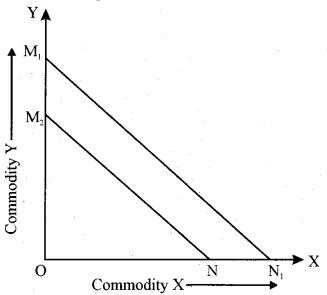
The initial lines MN, upon an increase in income the line M1 N1 moves upwards.
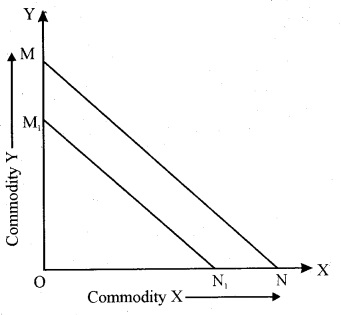
Initial line is MN, when the income decreases, the line M1N1 move downwards.
Question 3.
Write down assumptions of law of diminishing marginal utility.
Answer:
The assumptions of diminishing utility law are as below :
- The consumers’ behaviour is assumed to be discretional.
- Utility is measurable, and currency is used to measure it.
- The marginal utility of currency is assumed to be invariable.
- The process of consumption is continuous.
- The income, habits, interest, and fashion trends of the consumer do not change with time.
- The units of utilised commodity should be of appropriate size and homogeneous in context of their properties.
Question 4.
Write down the main characteristics of indifference curve.
Answer:
The main characteristics of indifference curve are the following:
(i) Indifference Curve has a Negative Slope : The negative slope of an indifference curve implies that the two goods are substitutes for one another. Therefore, if quantity of one commodity decreases, quantity of the other commodity must increase if the consumer has to stay at the same level of satisfaction.
(ii) Indifference Curves are Convex to Origin : The convexity of indifference curves implies :
(a) That the two goods are important substitutes for one another.
(b) That the marginal rate of substitution between the two goods decreases as a consumer moves along an indifference curve.
(iii) Indifference curves do not intersect nor are tangent to one another.
RBSE Class 12 Economics Chapter 2 Essay Type Questions
Question 1.
Explain consumer’s equilibrium in cardinal approach.
Answer:
Considering the perception of the cardinal utility approach, we turn to analyzing the consumer’s equilibrium. As a general rule, when a consumer maximizes the total utility of the expenditure done by. him, then the consumer reaches his equilibrium. To clarify consumer equilibrium, let’s start with a simple one-object case. Suppose a fixed income earner spends only on a commodity, X. His income is both utility for income and commodity X, so he can spend his money on commodity X or it will remain with .himself if he keeps all the total money and does not spend any amount on X, then the marginal utility of money commodity X less than (i.e., MUx) is greater than marginal utility of money income (MUm), total utility can be increased by exchanging money for the commodity.
Therefore, a utility maximizing consumer exchanges his money income for the commodity so long as MUx > MUm. As assumed earlier, marginal utility of commodity of X is subject to diminishing returns, whereas marginal utility of money income (MUm) remains constant. Therefore, the consumer will exchange his money income for commodity X so long as MUx > Px (MUm). The utility maximizing consumer reaches his equilibrium with the level of his maximum satisfaction where
MUx = Px (MUm) : (where MUm = 1)
Alternatively, the consumer reaches equilibrium whereas,

Consumer’s equilibrium in a single-commodity case is illustrated graphically in the given figure. The horizontal line Px (MUm) shows the constant utility of money weighted by Px, the price of commodity X, and MUm curve represents the diminishing marginal utility of commodity X.
The Px (MUm) line and MUx curve intersect at point E, where MUx – Px (MUm). Therefore, if consumer exchanges his money income for commodity X, he increases his satisfaction per unity of commodity. At any point below E, MUx < Px (MUm), the consumer can therefore increase his satisfaction by maximum. Therefore, point E is the point of consumer’s equilibrium.
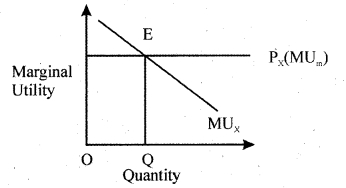
Figure shows the consumer’s equilibrium : One Commodity Case
Question 2.
Explain conditions of consumer’s equilibrium with the help of indifference curve.
Answer:
A consumer attains his equilibrium when he maximizes his total utility, given his income and prices of goods and services he consumes remains constant. According to ordinal utility approach, two conditions must be satisfied for the consumer to be in equilibrium. These are:
(i) The consumer will be in equilibrium at the point where price line is tangent to indifference curve. It is the point of maximum satisfaction.
(ii) The consumer is in equilibrium where price ratios are equal to marginal rate of substitution.
![]()
This is an essential condition of consumer’s equilibrium.
(iii) The third essential condition of consumer’s equilibrium is that at point of equilibrium, MRSxy should be declining. It simply means that indifference curve is convex to the origin.
Diagrammatic Representation of Consumer’s Equilibrium : To find out consumer’s equilibrium, a graph of indifference curve is drawn along with budget line. The indifference curve which is close to origin represents lesser satisfaction and the farther indifference curve represents higher satisfaction. Given the budget line, the consumer tries to attain highest indifference curve.
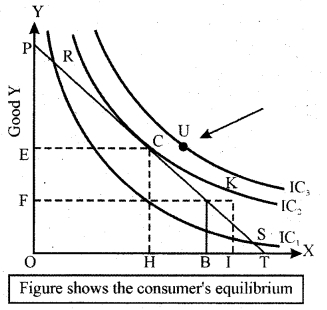
In figure, PT is budget line and IC1, IC2 and IC3 are three indifference curves. Given the budget line, the consumer may get maximujn satisfaction by IC2. This is consumers’ point C, budget line AB is tangent to indifference curve IC2. This is consumers’ equilibrium point. At this point, consumer purchases OH amount of X and OE amount of Y.
Conclusion : Cardinal approach is based on various unrealistic assumptions, therefore ordinal approach is superior to cardinal approach.
Question 3.
Explain the characteristics of indifference curve analysis.
Answer:
The main characteristics of indifference curve are the following:
(i) Indifference Curve has a Negative Slope : The negative slope of an indifference curve implies that the two goods are substitutes for one another. Therefore, if quantity of one commodity decreases, quantity of the other commodity must increase, if the consumer has to stay at the same level of satisfaction.
(ii) Indifference Curves are Convex to Origin : The convexity of indifference curves implies:-
(a) That the two goods are important substitutes for one another.
(b) That the marginal rate of substitution between the two goods decreases as a consumer moves along an indifference curve.
Convexity of the indifference curve is based on the postulate of diminishing marginal rate of substitution.
(iii) Indifference Curves Do Not Intersect Nor are Tangent to One Another : If two indifference curves intersect or are tangent to each other, it would mean that an indifference curve indicates two different levels of satisfaction or that two different combinations – one being larger than the other, produce the same level of satisfaction. Such conditions are impossible if consumer’s subjective valuation of a commodity is greater than zero. Also, if two indifference curves intersect, it would mean violation of consistency or transitivity assumption in consumer’s preferences.
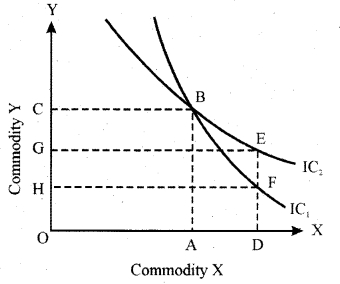
Let us now see what happens when two indifference curves IC1 and IC2, intersect at point B. Consider two other points – point F on indifference curve IC1 and IC2, and point E on indifference curve IC2, both falling on vertical line.
Points B, F.and E represents three different combinations of commodities X and Y. Note that combination B is common to both the indifference curves, it implies that, in terms of utility,
B = F
B = E
F = E
But, if F equals E, it would mean that in terms of utility,
OD of X + FD of Y = OD of X + ED of Y
Since, OD of X is common to both the terms, it means that FD of Y is equal to ED of Y.
But this is not so. Figure shows FD > ED. Therefore, combination F and E cannot be equal in terms of utility in the objective introspection of the consumer. The intersection, therefore, violates the transitivity rule which is a logical necessity in indifference curve analysis.
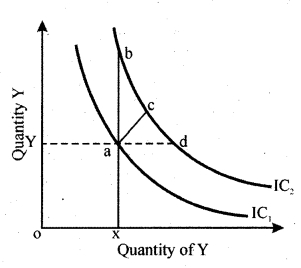
(iv) Higher Indifference Curves Represent a Higher Level of Satisfaction Than the Lower Ones : An indifference curve placed above and to the right of another represents a higher level of satisfaction than the lower one. The reason is that an upper indifference curve contains all along its length a larger quantity of one or both the goods than the lower one. And, a larger quantity of a commodity is supposed to yield a greater satisfaction than the smaller quantity of it, provided MU > 0
Comparison of Lower and Upper Indifference Curves
For example, consider the indifference curves IC1 and IC2. The vertical movement from point a on the lower indifference curve, IC1, to point b on the upper indifference curve, IC2, means increase in quantity of Y by ab, the quantity of X remaining the same (OX). Similarly, a horizontal movement from point a to d means a greater quantity of commodity X, quantity of Y remaining the same. A diagonal movement from point a to c means larger quantities of both X and Y. Unless the utility of additional quantities of X and Y are equal to zero, these additional quantities will yield additional utility. Therefore, the level of satisfaction indicated by the upper indifference curve (IC2) would always be greater than that indicated by the lower indifference curve (IC1).
Question 4.
Explain the law of equimarginal utility.
Answer:
Principle of equimarginal utility possesses an important place in marginal utility analysis. It is through this principle that consumer’s equilibrium has been explained. It is also called Law of substitution because it is good for the consumer to reach the equilibrium position. A consumer has a given income which he has to spend on various goods he wants. Now, the question is how he would allocate his money income among various goods, that is to say, what would be his equilibrium position in respect of the purchases of the various goods. It may be mentioned here that consumer is assumed to be ‘rational’ that is, he coldly and carefully calculates and substitutes goods for one another so as to maximize his utility or satisfaction.
Suppose there are only two goods X and Y on which a consumer has to spend a given income. The consumer’s behaviour will be governed by two factors. First, the marginal utilities of the goods and secondly, the prices of two goods. Suppose the prices of the goods are given for a consumer. The law of equimarginal utility states that the consumer will distribute his money income between the goods in such a way that the utility derived from the last rupee spent on each good is equal. In other words, consumer is in equilibrium position when marginal utility of money expenditure on each good is the same. Now, the marginal utility of money expenditure on a good is equal to the marginal utility of a good divided by the price of the

Where MUm is marginal utility of money expenditure and MUx is the marginal utility of X and Px is the price of good X. The law of equimarginal utility can. therefore be stated thus : the consumer will spend his money income on different goods in such a way that marginal utility of each good is proportional to its price. That is, consumer is in equilibrium in respect

different levels of expenditure. Thus, how far does a consumer go on purchasing the goods he wants, is determined by the size of his money expenditure. With a given money expenditure on a good, a consumer will derive some utility from it. Now, the consumer will go on purchasing goods until the marginal utility of money expenditure on each good becomes equal. Thus, a consumer will be in equilibrium when the following equation holds goods:

RBSE Class 12 Economics Chapter 2 Other Important Questions – Answers
RBSE Class 12 Economics Chapter 2 Multiple-Choice Questions
Question 1.
Prof. J.R. Hicks and Prof. J.D. Allen propounded the cardinal approach in the form of alternative analysis :
(a) in 1934
(b) in 1935
(c) in 1835
(d) in 1834
Answer:
(a)
Question 2.
Capacity of fulfillment of requirement of goods is called :
(a) Productivity
(b) Utility
(c) Ability
(d) Satisfaction
Answer:
(b)
Question 3.
Methods of utility analysis are :
(a) Cardinal analysis
(b) Ordinal analysis
(c) both
(d) None of these
Answer:
(c)
Question 4.
Utility in marginal utility theory is :
(a) ordinal utility
(b) cardinal utility
(c) both
(d) None of these
Answer:
(b)
Question 5.
If the marginal utility of goods is negative then the total utility is :
(a) declining
(b) increasing
(c) constant
(d) zero
Answer:
(a)
Question 6.
Diminishing marginal utility principle propounded by :
(a) Marshall
(b) Gossen
(c) pigou
(d) Edgeworth
Answer:
(b)
Question 7.
Assumptions of diminishing marginal utility are:
(a) the process of consumption is constant
(b) the marginal utility of wealth is assumed to be constant
(c) utility is measurable and money is use for this
(d) All of above
Answer:
(d)
Question 8.
Indifference means:
(a) X is given preference on Y
(b) Y is given preference on X
(c) Both X and Y are similar preferences
(d) None of these
Answer:
(c)
Question 9.
Assumptions of indifference curve analysis are:
(a) consumer are considered prudent
(b) the consumer’s tastes, habits and income remain the same throughout the analysis
(c) an indifference curve is negatively inclined sloping downward
(d) All of these
Answer:
(d)
Question 10.
Slope of budgetary constraints is :

Answer:
(c)
RBSE Class 12 Economics Chapter 2 Very Short Answer Type Questions
Question 1.
Define marginal utility.
Ans.
The marginal utility can be defined as the utility derived from the marginal or the last unit consumed.
Question 2.
Define total utility.
Ans.
Total utility is defined as the sum of the utility derived from all the units consumed of the commodity.
Question 3.
What is the meaning of consumer’s equilibrium?
Answer:
It is the state in which a consumer is said to be in equilibrium when he is buying such a combination of goods as leaves him with no tendency to rearrange his purchase of goods.
Question 4.
Define indifference curve.
Answer:
The basic tool of Hicks-Alien ordinal analysis of demand is the indifference curve which represents all those combinations of two goods which give same satisfaction to the consumer.
Question 5.
What is budget line?
Answer:
It is a line showing different possible combinations of Good-1 and Good-2, which a consumer can buy, given his budget and the prices of Good-1 and Good-2. Anywhere, on the budget line, a consumer is spending his entire income either on Good-1 or on Good-2 or on both Good-1 and Good-2.
Question 6.
What do you mean by ‘monotonic preferences’?
Answer:
Monotonic preference means that a rational consumer always prefers more of a commodity as it offers him a higher level of satisfaction.
Question 7.
What is meant by a ‘consumer’?
Answer:
A person who purchases goods and services for personal use.
Question 8.
What do you. understand by ‘consumption’? .
Answer:
Consumption means using something, buying or eating.
Question 9.
Who propounded the cardinal analysis as the alternative use in 1934?
Answer:
Prof. J.R. Hicks and Prof. R.G.D. Allen.
Question 10.
What is utility?
Answer:
Utility means power of any commodity to satisfy wants.
Question 11.
What is utility function?
Answer:
Individual’s demand for a product depends on price of a product, income of an individual, the prices of related goods.
Question 12.
How can we write the formula of total utility?
Answer:
TUn = U1 + U2 + U3 + Un TUn = Total utility of n units
Question 13.
How many methods of utility analysis are?
Answer:
Two methods of utility analysis are:
- Cardinal utility analysis
- Ordinal utility analysis.
Question 14.
Write down one assumption of utility analysis.
Answer:
Consumer is rational and he compares the utility drawn from different goods and measures and selects among them.
Question 15.
What is the point at which total utility is maximized?
Answer:
Point of satisfaction.
Question 16.
If the consumer is forced to release the use of that item even after the point of maximum satisfaction, then what effect does it have on the consumer?
Answer:
Total utility starts declining.
Question 17.
What is the formula of measuring marginal utility?
Answer:
![]()
Question 18.
What do you understand by positive marginal utility?
Answer:
Positive Marginal Utility can be defined as that good which does not follow the law of Diminishing Marginal Utility. In this case, if a consumer consumes more of that commodity, the marginal utility of that goods rises.
Question 19.
What is zero marginal utility?
Answer:
Since a person buys a product more, its marginal utility to the buyer will become less, until it reaches the point where the buyer does not have any (zero) requirement for any extra unit of service. At that point, the marginal utility of the next unit is equal to zero and this is called Zero Marginal Utility.
Question 20.
What is meant by negative marginal utility?
Answer:
When the one more unit of commodity gives dissatisfaction, this is called Negative Marginal Utility.
Question 21.
What is the effect of negative marginal utility on total utility?
Answer:
Total utility falls when marginal utility is negative.
Question 22.
If the marginal utility is zero, then how much will the total utility be?
Answer:
Total utility is maximum when marginal utility is zero.
Question 23.
What will be the effect on marginal utility after the point of saturation?
Answer:
After the point of saturation, it will be negative.
Question 24.
Who propounded the principle of diminishing marginal utility and when?
Answer:
Henrich Gossen in 1854.
Question 25.
Write down one assumption of diminishing marginal utility.
Answer:
Consumer’s taste and preferences remain unchanged during the period of consumption.
Question 26.
Which laws originates by diminishing marginal utility.
Answer:
Law of Demad, equimarginal utility law, etc. originate by diminishing marginal utility.
Question 27.
Write down one limitation of equimarginal utility law.
Answer:
Goods are often available in large indivisible units, it is not possible to equate the marginal utility of money spent on them.
Question 28.
In which field of economics does the equimarginal utility law apply?
Answer:
It is applied in the field of consumption, origin, investment and distribution.
Question 29.
What is that curve called, which represents different combinations of two goods which yield equal satisfaction to the consumer?
Answer:
Indifference curve.
Question 30.
What is the nature of slope of indifference curve?
Answer:
Negative (decline).
Question 31.
Write down a condition of consumer’s equilibrium by indifference curve.
Answer:
It is necessary that the indifference curve touces the budget line for consumer’s equilibrium.
Question 32.
Draw the diagram of indifference curve.
Answer:
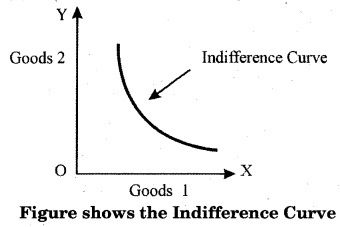
Question 33.
Express the indifference curve in equation.
Answer:
U = f (X1, X2, X3 ……. Xn) = K
Question 34.
State one characteristic of indifference curve.
Answer:
Indifference curve is convex to the origin.
Question 35.
What is budget line?
Answer:
Budget line is a graphical representation of all possible combinations of two goods which can be purchased with given income and prices, such that the cost of each of these combinations is equal to the money income of the consumer.
Question 36.
What is the formula of budget line slope?
Answer:
Slope of budget line = \(\frac { { P }_{ x } }{ { P }_{ y } } \)
Question 37.
The income of a consumer is ₹ 1000, he wants to consume two goods whose prices respectively are ₹ 10 and ₹ 15. Write down the equation of budget line.
Answer:
1000 = 10 × x1 + 15 × x2
Question 38.
What is meant by cardinal measurability utility?
Answer:
When a person can express utility or satisfaction which he derives from, the goods in quantitative terms, it is called Cardinal Measurability Utility.
Question 39.
What is indifference map?
Answer:
The set of indifference curves is called Indifference Map.
Question 40.
What is the marginal rate of substitution?
Answer:
The Marginal Rate of Substitution (MRS) is the rate at which one commodity can be substituted for another, the level of satisfaction remaining the same.
Question 41.
What are the inferior goods?
Answer:
Inferior goods are those goods whose demand decreases when the income of consumer increases.
Question 42.
What is meant by Engel curve?
Answer:
Engle curve is the graphical presentation of the relationship between equilibrium quantity purchased of a commodity and the consumer’s income.
Question 43.
What is marginal utility of money?
Answer:
Marginal utility of money refers to ‘worth of a rupee’ to a consumer.
RBSE Class 12 Economics Chapter 2 Short Answer Type Questions (SA-I)
Question 1.
What is meant by consumer’s taste and preferences?
Answer:
Consumer’s taste and preferences play an important role in determining the demand for a product. Taste and preferences depend, generally on the social customs, religious value associated with a commodity, habits of the people, the general life-style of the society and also the age and sex of the consumers. Change in these factors varies the taste and preferences of consumer. When there is a change in consumers’ choices, tastes and preferences for certain goods and services after the change in fashion, people switch their consumption pattern from cheaper and old-fashioned goods over to costlier ‘mod’ goods, so long as price differentials commensurate with their preference.
Question 2.
What do you understand by consumption?
Answer:
The act of using goods and services to satisfy human wants is called Consumption. According to Meyers, “Consumption is the direct use of goods and services in satisfying the human wants.” Consumption is the process through which human wants are satisfied.
Question 3.
What are the characteristics of utility?
Answer:
Following are the main characteristics of utility:
(i) Utility is subjective i.e., it cannot be observed and identified. It depends on the individuals own subjective estimate of the amount of satisfaction, that he wants to get from something.
(ii) Utility cannot be measured in objective terms. It cannot be quantified and cannot be measured by any measuring rod. However, some economists maintain that utility can be measured in terms of money.
(iii) Utility is not absolute but it is relative in view of its subjective nature. It is relative to a person’s need. Therefore, it varies from person-to-person.
(iv) Utility is abstract in the sense that it cannot be seen or touched.
Question 4.
Who propounded cardinal analysis?
Answer:
Cardinal analysis was rendered by the neo-classical economists like Marshall and Pigou. According to them, utility is measurable and it can be measured.
Question 5.
‘Utility can be measured in the form of utils.’ Write down the name of economists who agree with this idea.
Answer:
According to economists William Stanley Jevons, Carl Menger, Leon Walrus and Alfred Marshall, it is possible to measure utility as milk in litre, height in metre, distance in kilometre, degree in temperature.
Question 6.
Which method was propounded for the improvement of cardinal analysis and alternative analysis?
Answer:
Ordinal analysis method was propounded by Prof. J.R. Hicks and Prof. G.D. Allen in 1934 for the improvement of cardinal analysis and alternative analysis.
Question 7.
‘Utility is an intangible assumption.’ Clarify that statement.
Answer:
Utility can only be felt, it cannot be seen and cannot be touched, that’s why utility is an intangible assumption.
Question 8.
Is utility found in only beneficial commodity?
Answer:
No, utility is found in both beneficial commodity and non-beneficial commodity. Like milk, ghee, butter, etc. are beneficial goods, whereas alcohol and cigrattee are non-beneficial goods, but utility is found in all.
Question 9.
‘Utility is conditional.’ What dp you understand by this statement?
Answer:
This statement says that utility of a commodity is changed according to time and condition for a consumer.
Question 10.
What are the methods of utility analysis?
Answer:
There are two methods of utility analysis :
- Cardinal analysis
- Ordinal analysis.
Question 11.
‘Utility can be measured.’ Which economists said this?
Answer:
Edgewoth (1881), Antonelli (1886) and Irving Fisher (1892) said that utility can be measured and it depends upon the quantity of consumed goods by a consumer.
Question 12.
‘Utility is an abstract assumption.’ Clarify this statement.
Answer:
The utility can be realized only, it cannot be seen or touched, on this basis, we can say that utility is an abstract concept.
Question 13.
What is utility function? How can this be expressed in equation form?
Answer:
Utility of indifference curve expressed in numeric form is said to be utility function. It can be written like this
U(f) = U(X1, X2, X3 …. Xn)
Here, is X1; is the quantity of goods 1. It is the relation of function, which represents the taste of a person.
Question 14.
What is the relation between total utility and marginal utility? Tell one relationship.
Answer:
The point where the total utility is maximized, the marginal utility at the same point is zero.
Question 15.
Why does MRS diminish?
Answer:
The negative slope of the indifference curve means that two commodities can substitute one another only to a limited extent. In fact, any two goods cannot be considered perfect substitutes for each other. In case they are perfect substitutes, the indifference curve will be a straight line with a negative slope. Since most goods are not perfect substitutes, the subjective value (i.e., MU) attached the additional quantity of a commodity decreases faster in relation to the other commodity whose total quantity decreases. Therefore, when the quantity of one commodity increases (X) and that of other (Y) decreases, it becomes increasingly expensive for the consumer to sacrifice more units of commodity Y for one unit of X. Therefore, when a consumer needs to sacrifice additional units of Y, he will require increasing units of X to maintain the level of his satisfaction. Consequently, the MRS decreases.
Question 16.
What is the importance of the law of diminishing marginal utility?
Answer:
This law is used for public finance. We know that the utility of money is low for rich and it is high for the poor people, therefore by imposing tax on the rich, social welfare increases by spending that amount on poor people.
Question 17.
What is the condition of consumer’s equilibrium in cardinal analysis?
Answer:
In the condition of one commodity,
MUx = Px
In the condition of two commodities,

Question 18.
What are the two demerits of equimarginal utility?
Answer:
(i) It has been said that it is not possible to measure the consumer’s cardinal utility. There is no specific unit to measure the utility along with the state of emotion, it is cardinally immeasurable. It is because of the immeasurability of utility in cardinal terms that consumer’s behaviour has been explained with the help of ordinal utility by J.R. Hicks and R.G.D. Allen.
(ii) Goods are often available in large indivisible units. Because the goods are indivisible, it is not possible to equate the marginal utility of money spent on them.
Question 19.
What is the importance of equimarginal utility?
Answer:
Equimarginal utility is used for maximum production through limited resources, which reduces the cost per unit. It occupies an important role in marginal utility analysis. It is through this principle that in consumer’s equilibrium position, the consumer substitutes one good for another.
Question 20.
Write down two characteristics of indifference curve.
Answer:
(i) Indifference curves have a negative slope. The negative slope of an indifference curve shows that the two goods are substitutes for one another. Therefore, if quantity of one commodity decreases, quantity of the other commodity must increase if the consumer has to stay at the same level of satisfaction.
(ii) Indifference curves are convex to origin. Indifference curves for normal goods are not only negatively sloping, but are also convex to the origin.
Question 21.
What do you understand by indifference curve?
Answer:
An indifference curve can be defined as the locus of points, each representing a different combination of two goods yielding the same utility or level of satisfaction. Therefore, a consumer is indifferent between any two combinations of goods when it comes to making a choice between them.
Question 22.
What is the difference between utility approach and indifference curve approach?
Answer:
Utility is a cardinal approach, it is measurable in the term of money, whereas indifference curve is based on ordinal approach and it cannot be measured in terms of money.
Question 23.
What do you mean by budgetary constraints?
Answer:
The limitedness of income acts as a constraint on the utility maximizing behaviour of the consumer, this is known as Budgetary Constraint. The budgetary constraint, assuming a two-commodity model, may be expressed as:
Px Qx + Py Qy = M
Where Px and Py are prices of X and Y respectively, and Qx and Qy are their respective quantities, and M is consumer’s money income.
Question 24.
What do you understand by consumer’s surplus?
Answer:
It has been generally seen that consumers are ready to pay more for commodities than they actually pay for them. This extra satisfaction which consumers get from their purchase of goods is called by Marshall as Consumer Surplus. The concept of consumer’s surplus was developed by Alfred Marshall. This concept is not only applicable in economic theory, but also in the economic position of government and monopoly decisions.
Question 25.
Write down three limitations of consumer’s surplus.
Answer:
- The consumer’s surplus cannot be measured exactly because it is difficult to measure the marginal utility of different units of a commodity consumed by a person.
- In the case of necessaries, the marginal utilities of the earlier units are infinitely large. In such case, the consumer’s surplus is always infinite.
- There is no simple rule for deriving the utility scale of articles which are used for their prestige value (e.g., diamonds).
Question 26.
What do you meant by convexity of IC?
Answer:
IC is often convex to origin. It implies that its slope tends to decrease as we move along it from left to right. Since slope of IC is the same as MRS we can say that convexity of IC implies diminishing MRS.
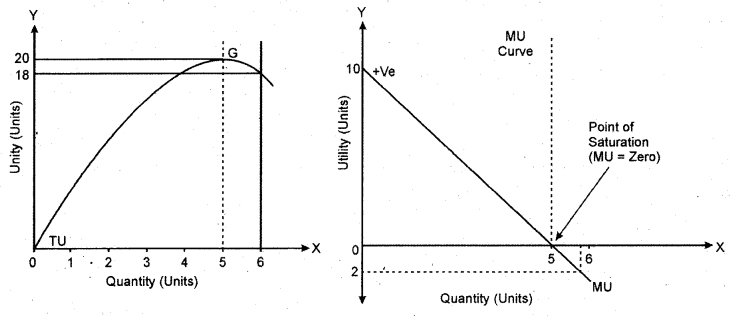
(i) TU curve represents total utility. It slopes upwards upto point ‘G’. Point ‘G’ represents maximum total utility at the 5th unit. After point ‘G’, TU slopes downwards, meaning thereby, that at the 6th unit marginal utility becomes negative and total utility begins to fall.
(ii) MU curve represents marginal utility. It slopes downwards from left to right. It means that marginal utility of successive units goes on diminishing.
Question 27.
What will be the changes in the budget line, if the income of the consumer becomes ₹ 40 instead of ₹ 20, but the price remains unchanged?
Answer:
If the income of the consumer increases to ₹ 40 while the price remains unchanged, then the proportion of the increase in the budget line earnings will move ‘ upwards to the right. Because the income has doubled than its previous value, consumers will be able to purchase two-fold quantities of both items.
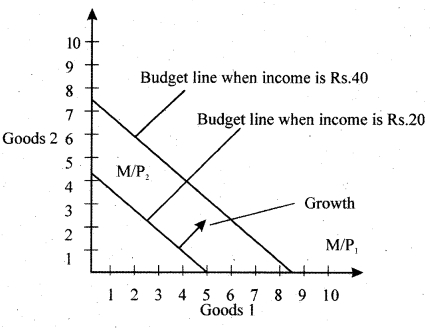
Question 28.
What will be the changes in budget line, if there is a change in cost of ₹ 1 in Goods 2, hut Goods 1 and income remains unchanged?
Answer:
Income of Consumer (M) = ₹ 20
Price of Goods 1 (P1) = ₹ 4 unit
New Cost of Goods 2 (P2) = 5 – 1 = ₹ 4 unit
If after the declining of Goods-2 cost, consumer bought goods from his total income then he would be able to purchase 20/4 = 5 units
Therefore, consumer can buy comparatively more goods than before.
Diagram will be made like this –
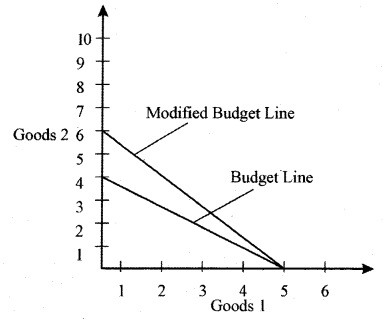
Above graph makes it clear that budget line shifted towards Y-axis but it is constant on that point on X-axis.
Question 29.
What is budget space?
Answer:
A budget space shows a set of all commodity combinations that can be purchased by spending the whole or a part of the given income. In other words, budget space represents all those combinations of the commodities which a consumer can afford to buy, given the budget constraint.
RBSE Class 12 Economics Chapter 2 Short Answer Type Questions (SA-II)
Question 1.
Define marginal utility.
Answer:
Marginal utility of a commodity to a consumer is the extra utility which he gets when he consumes one more unit of the commodity. It can be defined as the utility derived from the marginal or the last unit consumed. More precisely, Marginal Utility (MU) is the change in the total utility resulting from the consumption of one additional unit. That is,
MU = \(\frac { \triangle TU }{ \triangle C } \)
Where ∆TU = change in total utility, and ∆C = change in consumption by one unit
Marginal unit (MU) may also be expressed as
MU = TUn – Tn-1
Where TUn = total utility derived from the consumption of n units and TUn-1 = total utility derived from the consumption of n – 1 units.
Question 2.
State the law of diminishing marginal utility.
Answer:
The law of diminishing marginal utility is central to the cardinal utility analysis of consumer behaviour. This law states that as the consumption of the commodity increases per unit of time, the utility derived by the consumer from the successive units, decreases continuously, provided the consumption of all other goods remains constant. This law stems from the facts –
(i) that the utility derived from a commodity depends on the intensity or urgency of the need for that commodity, and
(ii) that as more and more quantity of a commodity is consumed, the intensity of desire decreases. For this reason, the utility derived from the marginal units goes on diminishing.
Question 3.
What is meant by consumer’s equilibrium? State the conditions required for equilibrium.
Answer:
Consumer’s equilibrium refers to a situation in which the consumers get maximum satisfaction from their income and there is no tendency to make any change in their current expenditure. In other words, a consumer is in equilibrium when he considers his actual behaviour to be the best possible in the circumstances and there is no need to change his behaviour till circumstances remain unchanged.
The following two conditions are required for the consumer to be in equilibrium:
(i) A given budget line must be tangent to an indifference curve, or marginal rate of
substitution of X for Y (MRSxy) must be equal to the price ratio of the two goods Px/Py.
(ii) Indifference curve must be convex to the origin at the point of tangency.
Question 4.
Ice cream sells for ₹ 40. Rohan who likes ice cream has already consumed 8. Her marginal utility of one rupee is 8. Should she consume more ice cream or stop the consumption? .
Answer:
A consumer attains equilibrium when:

Substituting the given values, we get MUx/8 = 40 implying that, in a state of equilibrium, Rohan’s MUx must be equal to 320. If, having consumed 8 ice creams, Rohan’s MUx = 320 he must stop consuming more. However, if MUx > 320 he should consume more ice creams till MUx reduces to 320 and in terms of its money worth is equal to Px = 40.
Question 5.
Estimate the value of total utility and marginal utility from the following table
| Units Consumed (Commodity X) | TUx |
| 1 | 200 |
| 2 | 390 |
| 3 | 570 |
| 4 | 740 |
| 5 | 900 |
Answer:
| Units Consumed | TUx | Marginal Utility |
| 1 | 200 | 200 |
| 2 | 390 | 190 |
| 3 | 570 | 180 |
| 4 | 740 | 170 |
| 5 | 900 | 160 |
The table shows:
(i) MUn = TU – Tun-1
(ii) TU = ∑MU
= [200 + 190 + 180 + 170 + 160] = 900
Question 6.
Convert this table into a diagram which shows the relation of total utility and marginal Utility.
| Units Consumed | TUX | Marginal Utility |
| 1 | 200 | 200 |
| 2 | 390 | 190 |
| 3 | 570 | 180 |
| 4 | 740 | 170 |
| 5 | 900 | 160 |
Answer:
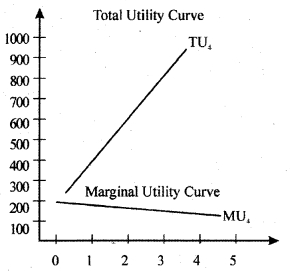
Figure shows the relation between total utility and marginal utility
Question 7.
Rita has ₹ 88 with her. She intended to purchase goods X and Y with her money. The market price of X and Y per unit is ₹ 8. The marginal utility schedule of goods X and Y is given below. Find out how many units of X and Y should Rita purchase so that she will get maximum satisfaction.
| Units of Commodity | MUy | muy |
| 1 | 88 | 40 |
| 2 | 72 | 36 |
| 3 | 64 | 24 |
| 4 | 56 | 20 |
| 5 | 48 | 16 |
| 6 | 40 | 12 |
| 7 | 32 | 8 |
| 8 | 24 | 4 |
| 9 | 16 | 0 |
| 10 | 8 | 0 |
Answer:
We know, in case of two commodities, a consumer strikes equilibrium when:

In the present case, Px = Py = ₹ 8 per unit so that, equilibrium would be struck when
MUx = MUy, according to equation (i)
Or, when MUx/MUy = 8/8 = 1, according to equation (ii)
It occurs when Rita purchases 8 units of X (spending 8 × 8 = ₹ 64) and 3 units of Y (spending 3 × 8 = ₹ 24)
Consider combination X = 6 and Y = 1, here also MUx = MUy. But it is not an equilibrium point because here all income is not spent i.e., affordable in terms of consumer’s income.
Here, consumer’s expenditure exceeds his income i.e., 72 ( = 9 × 8) + 40 ( = 5 × 8) = 112 > 88.
Question 8.
Distinguish between marginal utility and total utility.
Answer:
| Basis of Comparison | Total Utility | Marginal Utility |
| Meaning | Total utility means total gain acquired by a person from consumption of goods and services. | Marginal utility meants the amount of utility a person gains from the consumption of each gradual unit of a commodity. |
| Conclusion | Suffers from diminishing returns. | Consumption decreases for each additional unit. |
Question 9.
How do we prove that a higher IC offers a higher level of satisfaction?
Answer:
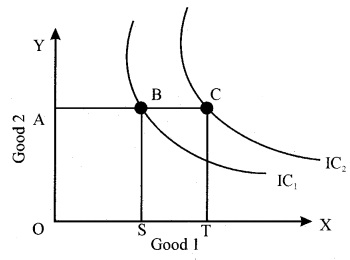
Point B is on IC1 and point G is on IC2.
At B, a consumer gets OA, OS combination (or bundles) of goods.
At C, a consumer gets OA, OT combination of goods.
Certainly OT > OS. Implying that at C a consumer gets more of Good-1 and the same amount of Good-2 as at B. We know according to his monotonic preferences, a rational consumer gets more satisfaction from more of good. Accordingly, C on IC2 (or any other point on IC2) must offer the consumer greater satisfaction than B on IC1 (or any other point on IC1). Hence, it is proved that a higher IC implies a higher level of satisfaction.
Question 10.
Why should the MRS be low?
Answer:
Let’s think the consumer has two commodities : Good-1 and Good-2, if the consumer has more of Good-1, his intensity of desire to have it reduces. On the other hand, as he is having minimum and less of Good-2, his intensity of desire to have it tends to rise. Accordingly, for every additional unit of Good-1, a consumer is willing to give up less and less amount of Good-2. Given figure illustrates this point clearly.
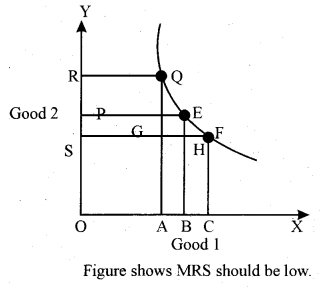
In figure, AB = BC. For the sake of simplicity, AB = GE. To have additional GE, the consumer is willing to give up QG. Subsequently, to have additional HF = GE, the consumer is willing to give up only EH. Apparntly EH < QG. Implying that .as we move along on IC (which is convex to the origin), we find that a consumer is willing to give up less and less amount of Good-2 for a unit more of Good-1. Implying that MRS tends to diminish.
Question 11.
ICs never touch or intersect each other, prove it.
Answer:
What happens if ICs are shown to be intersecting, as given in the following diagram:
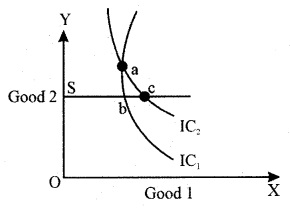
IC1 and IC2 are intersecting at point a. Points a and b are on IC2, implying a = b in terms of the level of satisfaction. Likewise, points a and c are on IC2, implying that a = c. If a = b, and a = c, then we can infer that b = c. But c is definitely better than b. Because point c offers the same amount OS of Good-2 as to point b, but greater amount of Good-1. At c, consumer is getting sc amount of Good-1 while at b he is getting only sb amount of Good 1 sb < sc, apparently. So that point c must be offering a higher level of satisfaction to the consumer than point b. The intersecting IC1 and IC2 however, reveal that b and c are equal. This must be wrong and hence proved that ICs never touch or intersect each other.
Question 12.
What are the principal properties of ICs?
Answer:
The four principal properties of ICs are:
- A higher IC (which is to the right and above another IC) offers a higher level of satisfaction.
- ICs are convex to the origin, so that MRS tends to diminish.
- ICs are negatively sloped, or they slope downward.
- ICs never touch or intersect each other.
Question 13.
The total utility schedule of individual ‘A’ is given below. Derive his marginal utility schedule.
| Units Consumed | Total Utility |
| 0 | 0 |
| 1 | 30 |
| 2 | 45 |
| 3 | 58 |
| 4 | 68 |
| 5 | 75 |
Answer:
| Units Consumed | Total Utility | Marginal Utility |
| 0 | 0 | 0 |
| 1 | 30 | 30 |
| 2 | 45 | 15 |
| 3 | 58 | 13 |
| 4 | 68 | 10 |
| 5 | 75 | 7 |
Question 14.
Marginal utility schedule of individual ‘A’ is given below. Derive his total utility schedule. (Assume that total utility of consuming zero units is zero.)
| Units Consumed | Marginal Utility |
| 1 | 7 |
| 2 | 10 |
| 3 | 8 |
| 4 | 6 |
| 5 | 3 |
| 6 | 0 |
Answer:
| Units Consumed | Marginal Utility | Total Utility |
| 1 | 7 | 7 |
| 2 | 10 | 17 |
| 3 | 8 | 25 |
| 4 | 6 | 31 |
| 5 | 3 | 34 |
| 6 | 0 | 34 |
Question 15.
What do you understand by law of equimarginal utility ? How does it explain consumer’s equilibrium?
Answer:
Where marginal utility of each commodity per unit of expenditure is the same, this is called the Law of Equimarginal Utility. Principle of equimarginal utility occupies an important place in marginal utility analysis. It is through the principle that consumer’s equilibrium is explained. It is also called Law of Substitution because in it for reaching equilibrium position consumer substitutes one good for another.
A consumer has a given income which he has to spend on various goods he wants. Now, the question is how he would allocate his money income among various goods, that is to say, what would be his equilibrium position in respect of the purchases of the various goods. It may be mentioned here that consumer is assumed to be ‘rational’, that is, he coldly and carefully calculates and substitutes goods for one another so as to maximize his utility or satisfaction.
Question 16.
Draw the budget line and throw light on the feasibility and non-feasibility area of budget line.
Answer:
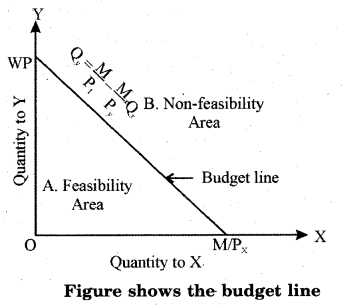
The budget line divides the commodity space into two parts which may be termed as:
(i) Feasibility Area: The area recumbent in the South-West of the budget line is feasibility area. Any combination of goods X and Y which is represented by a point in this area (ie.g., point A) or on the boundary line (i.e., budget line) is a feasible combination, given M, Px and Py.
(ii) Non-Feasibility Area : The area in the North-East of the budget line is non-feasibility area because any point falling in this area, e.g.,point B, is unattainable (given M, Px and Py).
Question 17.
Why it is tough to measure utility?
Answer:
It is tough to measure utility because it is based on psychological facts. The utility received by the consumption of commodity X can be different from the utility received by the consumption of commodity Y. Utility varies from place to place, time to time and person to person. It is conditionable.
Question 18.
How many methods of utility analysis are there?
Answer:
There are two methods of utility analysis. These are:
(i) Cardinal Analysis : Cardinal or marginal utility analysis is an important theory of consumer’s behaviour which provides an explanation of consumer’s demand for a product and derives the law of demand which establishes an inverse relationship between price and quantity demanded for a product.
(ii) Ordinal Analysis : It is a powerful analytical tool of consumer analysis. Ordinal utility is not a quantity or a numerical value. It is only an expression of the consumer’s preference for one commodity over another or for one basket of goods over another.
Question 19.
On which assumptions is cardinal analysis based?
Answer:
The cardinal analysis is based on assumptions given below:
- Rationality
- Limited money income
- Maximisation of satisfaction
- Utility is cardinally measurable
- Diminishing marginal utility
- Constant utility of money
- Utility is additive.
Question 20.
What are the stages of total utility? Describe them.
Answer:
Total utility has the following three stages:
(i) First Stage : In this stage, as unit consumption of goods increase, the total utility also increases.
(ii) Second stage : In this stage, the progress of total utility stops and this situation is called Point of Satisfy action.
(iii) Third Stage : In this stage, the total utility reduces and this situation is called Diminishing of Total Utility. These stages can be clarified by the given schedule:
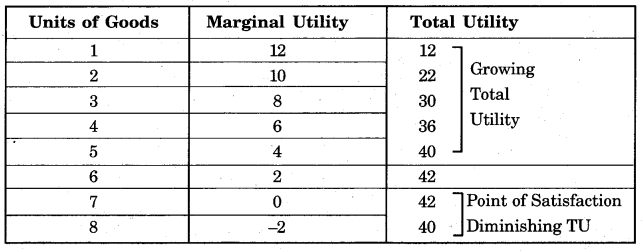
Question 21.
What are the forms of marginal utility?
Answer:
Following are the three forms of marginal utility:
(i) Positive Marginal Utility : When the consumer is satisfied by the consumption of additional unit of commodity.
(ii) Negative Marginal Utility: When the consumer is never satisfied by the consumption of goods.
(iii) Zero Marginal Utility : When the consumer gets neither satisfaction nor dissatisfaction by the consumption of goods, it is called Zero Marginal Utility.
These forms are clarified by the given schedule:
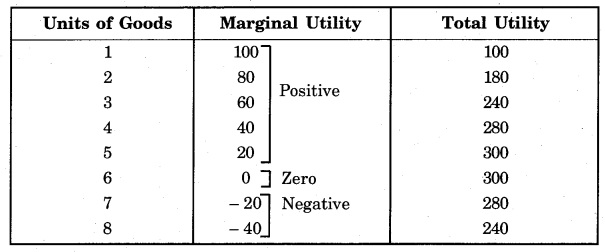
Question 22.
Write down the drawbacks of cardinal utility analysis.
Answer:
Three drawbacks of cardinal utility analysis are:
- Cardinal measurability of utility is unrealistic.
- Hypothesis of independent utilities is wrong.
- Assumption of constant cardinal utility of money is not valid.
- Marshallian Law of Demand cannot genuinely be derived except in a one-commodity case.
- Cardinal utility analysis does not split up the price effect into substitution and income effects.
- Marshall could not explain Giffen Paradox.
- Cardinal utility analysis assumes too much and explains too little.
Question 23.
Critically evaluate the concept of consumer’s surplus.
Answer:
The following is the critical evaluation of the concept of consumer’s surplus:
- Consumer’s surplus is fiction, fantasy and misleading because most consumers cannot pay for more than their income.
- It is based upon the invalid concepts that different units of the goods give different amount of satisfaction to the consumer.
- It ignores the interdependence between the goods, that is the relationships between substitute and complementary goods.
- It is based upon questionable assumptions of cardinal measurability of utility and constancy of the marginal utility of money.
Question 24.
What is the budget set and when does it change?
Answer:
A budget set or opportunity set includes all the possible consumption bundles, which one can spend on a given cost of goods and at the person’s given income level. The budget set is bound by the budgetary line, graphically speaking, all consumption bundles that are between budget constraints and budget line are included in budget set or opportunity set.
RBSE Class 12 Economics Chapter 2 Long Answer Type Questions
Question 1.
Briefly compare the cardinal and ordinal utility approaches.
Answer:
Most of the assumptions created under the two approaches are similar. For example, both cardinal and ordinal approaches consider the consumer’s rationality, transitivity of choices, limited income, perfect knowledge and utility maximization. The diminishing marginal utility assumption of the cardinal utility approach lies in the diminishing marginal rate of substitution assumption of the ordinal utility approach. Both cardinal and ordinal utility approaches use identical equilibrium condition. The necessary equilibrium condition of cardinal utility approach

The second order equilibrium condition of cardinal utility approach is that the total expenditure must not exceed consumer’s total income. Ordinal utility approach makes a similar assumption in two goods X and Y, given their prices as Px and Py, then
Qx Px + Qy Py = M
Thus, inspite of the fact that cardinal and ordinal approaches are based on different assumptions regarding the measurability of utility, both arrive at the same conclusion.
Question 2.
How does a consumer reach equilibrium position when he is buying only one commodity?
Or
Explain consumer’s equilibrium in case of a single commodity, with the help of a utility schedule.
Answer:
Let’s say that a consumer with certain money income consumes only one commodity, X. Since both his money income and commodity X have utility for him, he can either spend his money income on commodity X or retain it with himself. If he has total money and no commodity X, marginal utility of money will be lower than that of commodity X. So as long as marginal utility of commodity X (i.e.,MUx) is greater than marginal utility of money income (MUm), total utility can be increased by exchanging money for the commodity.
Therefore, a utility maximizing consumer exchanges his money income for the commodity as long as MUx > MUm. Marginal utility of commodity of X (MUx) is subject to diminishing returns, whereas marginal utility of money income (MUm) remains constant. Therefore, the consumer will exchange his money income for commodity X as long as MUx > Px (MUm). The utility maximizing consumer reaches his equilibrium with the level of his maximum satisfaction where
MUx = Px (MUm) (Where MUm = 1)
Let marginal utility of money for you = 5 utils (referring to your satisfaction from your standard set of goods available for a rupee)
Let X be the commodity you intend to buy.
Let Px (Price of X) = 4
Marginal utility schedule of X is as follows:
| Units of X |
MUx |
| 1 | 40 |
| 2 | 28 |
| 3 | 16 |
| 4 | 10 |
| 5 | 0 |
| 6 | -5 |
Now comes the decision of how many units of X to be purchased.
Let us proceed step by step:
Will you buy 1st unit of X?
Yes, because
Worth of a rupee to you = 4 utils
MUx = 40 utils = worth of ₹ 10
Px = ₹4
What you pay (₹ 4) is less than what you get (worth ₹ 10). Hence, you must buy the 1st unit of X.
Will you buy second unit of X?
Yes, because
Worth of a rupee to you = 4 utils
MUx = 28 utils = worth of ₹ 7
What you pay (₹ 4) is less than what you get (worth ₹ 7). Hence, you must buy the Ilnd unit of X,
Will you buy third unit of X ?
Yes, because
Worth of a rupee to you = 4 utils
MUx = 16 utils = Worth of ₹ 4
What you pay (₹ 4) is equal than what you get (worth ₹ 4). Hence, you must buy the Illrd unit of X also.
Now, consumer strikes his equilibrium because when he will buy the next unit then Worth of rupee to you = 4 utils
MUx = 10 utils = worth of ₹ 2.5
What you pay (₹ 4) is more than what you get (worth ₹ 2.5). Hence, you will not buy the IVth unit of X.
Question 3.
What are the assumptions of cardinal utility approach?
Answer:
Assumptions of cardinal utility approach are the following:
(i) Rationality : It is believed that the consumer has a rational sense that he satisfies his wants according to his satisfaction. This means that he buys first a commodity which yields the highest utility and he buys last a commodity which gives the least utility.
(ii) Limited Money Income : Consumers have limited money in order to spend on goods and services, which they have chosen to continue using.
(iii) Maximisation of Satisfaction : Every rational consumer intends to maximize his satisfaction from his given money income.
(iv) Utility is Cardinally Measurable : The cardinalists assume that utility is cardinally measurable, i.e. it can be measured in absolute terms and in cardinal numbers.
(v) Diminishing Marginal Utility : The cardinalists assume that the utility gained from successive units of a commodity consumed decreases as a consumer consumes more and more units of it.
(vi) Constant Utility of Money : The marginal utility of money remains constant whatever the level of consumer’s income and each unit of money has utility equal to 1.
(vii) Utility is Additive : Cardinalists maintain that utility is not only cardinally measurable but also it is additive. The additivity of utility can be expressed through a utility function.
Question 4.
What are the assumptions of ordinal utility approach?
Answer:
Assumptions of the ordinal utility theory are given below:
(i) Rationality : A consumer is considered a rational being. His goal is to maximize his total satisfaction. Given his income and prices of goods and services he consumes, his decisions are consistent with his objective. Apart from this, they have full knowledge about their circumstances and circumstances which are essential for a rational decision.
(ii) Ordinal Utility : Unlike cardinal utility approach, ordinal utility approach assumes that utility is only ordinally measurable by consumer’s subjective evaluation. That is, a consumer is able to express only the order of his preferences.
(iii) Transitivity and Consistency of Choice : Consumer’s choices are assumed to be transitive. Transitivity of choice means that if a consumer prefers A to B and B to C, he must prefer A to C. Or, if he treats A = B and B = C, he must treat A = C. Consistency of choice means that if a consumer prefers A to B in one period, he must not prefer B to A in another period or treat them as equal, everything remaining the same. The transitivity and consistency in consumer’s choices may be symbolically expressed as follows :
Transitivity : If A > B, and B > C, then A > C.
Consistency : If A > B in one period, then B > A or B = A in another.
(iv) Non-satisfaction : Non-satisfaction means that the consumer is not able to reach the point of saturation in case of any commodity and he is not oversupplied with goods in question. Therefore, a consumer always likes a larger quantity of all the goods.
Uncompromising means that the consumer is not able to reach the point of saturation in the case of any object and the question of excess amounts of goods does not arise. Therefore, a consumer always likes a large amount of all the items.
(v) Diminishing Marginal Rate of Substitution : The marginal rate of substitution is the rate at which a consumer is willing to substitute one commodity (X) for another (Y) so that his total satisfaction remains the same. This rate is given by ∆Y/∆X. The assumption is that ∆Y/∆X goes on decreasing, when a consumer continues to substitute X for Y.
Question 5.
What are the applications and uses of diminishing marginal utility?
Answer:
The marginal utility analysis has a good number of uses and applications in both economic theory and policy. Following are the applications and uses of diminishing marginal utility:
(i) The law of diminishing marginal utility is of crucial significance in explaining determination of the prices of commodities. The discovery of the concept of marginal utility has helped to explain the contradiction of money which troubled Adam Smith in ‘The Wealth of Nations’. Adam Smith was greatly perplexed to know why water which is so very essential and useful to life has such a low price (indeed no price), while diamonds which are quite unnecessary, have such a high price. This value paradox is also known as Water-Diamond Paradox. But modern economists can solve it with the help of marginal utility concept. According to the modern economists, the total utility of a commodity does not determine the price of a commodity and it is the marginal utility which is crucially, an important determinant of price. Now, the water is available in abundant quantities so that its relative marginal utility is very low or even zero. Therefore, its price is low or zero.
(ii) Another important use of marginal utility is in the field of fiscal policy. In the modern welfare state, the Government redistributes income so as to increase the welfare of the people. This redistribution of income through imposing progressive income taxes on the rich sections of the society and spending the tax proceeds on social services for the poor people is based upon the diminishing marginal utility. The concept of diminishing marginal utility demonstrates that transfer of income from the rich to the poor will increase economic welfare of the community.
Question 6.
What is meant by marginal rate of substitution? What is its relationship with marginal utility?
Answer:
The Marginal Rate of Substitution (MRS) is the rate at which one commodity can be substituted for another, the level of satisfaction remaining the same. The MRS is given by the slope of the IC curve. The concept of marginal rate of substitution is an important tool of indifference curve analysis of demand. The rate at which the consumer is prepared to exchange goods X and Y is known as Marginal Rate of Substitution.
Let’s take a look at our indifference schedule given in the table below :

In the beginning, the consumer gives up 4 units of Y for the gain of one additional unit of X, and in this process, his level of satisfaction remains the same. It follows that one unit gain in X fully compensates him for the loss of 4 units of Y. It means that at this stage, he is prepared to exchange 4 units of Y for one of X. Therefore, at this stage, consumer’s marginal rate of substitution of X for Y is 4. Thus, we may define the marginal rate of substitution of X for Y as the amount of Y whose loss can just be compensated by a unit gain in X. In other words, marginal rate of substitution of X for Y represents the amount of Y which the consumer has to give up for the gain of one additional unit of X so that his level of satisfaction remains the same.
In the table, when the consumer moves from combination B to combination C on his indifference schedule, he forgoes 3 units of Y for additional one unit gain in X. Hence, the marginal rate of substitution of X for Y is 3. Likewise, when the consumer moves from C to D, and then from D to E in his indifference schedule, the marginal rate of substitution of X for Y is 2 and 1 respectively.
Relation of Marginal Rate of Substitution (MRSxy) with Marginal Utilities
Since along an indifference curve total utility or satisfaction remains the same, gain in utility by consuming an extra unit of good X is offset by loss of utility from a certain units of Y given up. Therefore, net gain in utility along a given indifference curve is zero.

Since along in indifference curve, gain in utility from an extra unit of X is equal to loss of utility from units of good Y given up, therefore
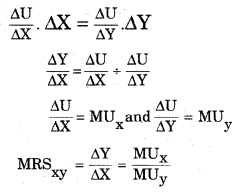
It follows from above that marginal rate of substitution of good X for good Y is equal to the ratio of marginal utilities of the two goods.
Question 7.
Why do the indifference curves neither intersect nor are tangent to one another?
Answer:
If two indifference curves intersect or be tangent to each other, it would mean that an indifference curve indicates two different levels of satisfaction or that two different combinations-one being larger than the other, yield the same level of satisfaction. Such conditions are impossible if consumer’s subjective valuation of a commodity is greater than zero. Also, if two indifference curves intersect, it would mean violation of stability or transitivity assumption in consumer’s preferences.
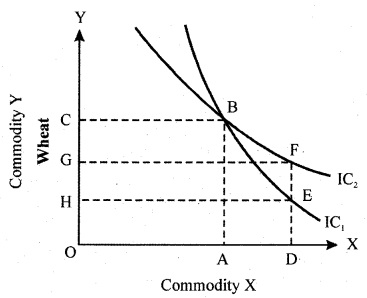
Suppose when two indifference curves IC1 and IC2, intersect at point B. Consider two other points – point F on indifference curve IC2 and point E on indifference curve IC1 both falling on vertical line.
Points B, F and E represent three different combinations of commodities X and Y. Note that combination B is common to both the indifference curves, it implies that, in terms of utility,
B = F
B = E
F = E
But, if F equals E, it would mean that in terms of utility,
OD of X + FD of Y = OD of X + ED of Y
Since OD of X is common to both the terms, it means that FD of Y is equal to ED of Y. But, this is not so. Figure shows FD > ED. Therefore, combinations B and C cannot be equal in terms of utility in the objective introspection of the consumer. The intersection, therefore, violates the transitivity rule which is a logical necessity in indifference curve analysis.
Question 8.
What do you understand by indifference curve of perfect substitutes and perfect complements?
Answer:
The degree of convexity of an indifference curve depends on the rate of decline in the marginal rate of substitution of X for Y. When two goods are the perfect substitutes of each other, the indifference curve is a straight line on which marginal rate of substitution remains constant. Straight line indifference curves of perfect substitutes are shown in given figure. The better the substitutes two goods are for each other, the closer the indifference approaches to the straight line, so that when the two goods are perfect substitutes, the indifference curve is a straight line. In case of perfect substitutes, the indifference curves are parallel straight lines.because the consumer equally prefers the two goods and is willing to exchange one good for the other at a constant rate. As one moves along a straight line indifference curve of perfect substitutes, marginal rate of substitutions of one good for another remains constant. For example, two different brands of tea such as Tata Tea and Tajmahal Tea, two different brands of cold drink such as Pepsi and Thums Up.
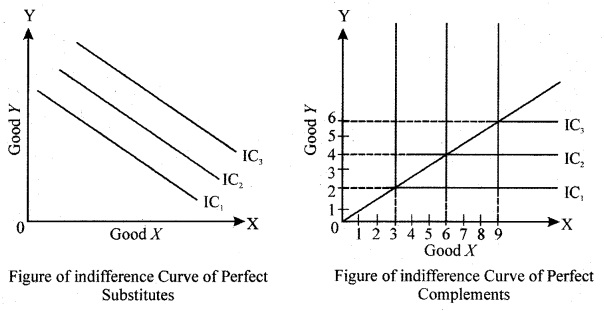
The greater the decline in marginal rate of substitution, the more the convexity of the indifference curve. The less the ease with which two commodities can be alternative for each other, the more will be the decline in marginal rate of substitution. At the highest, when two goods cannot at all be substituted for each other, that is, when the two goods are perfect complementary goods, as for example bread and butter, the indifference curve will consist of two straight lines with a right angle bent which is convex to the origin. Perfect complementary commodities are utilized in a certain fixed ratio.
The left hand portion in figure of an indifference curve shows the perfect complementary goods through vertical straight line which indicates that an endless amount of Y is necessary to substitute one unit of X, and the right hand side portion in figure of an indifference curve shows horizontal straight line which means that an endless amount X is necessary to substitute unit of Y all means that the two perfect complements are utilized in a certain fixed ratio and cannot be substituted for each other.
Figure shows that two perfect complements are consumed in the ratio, 3X : 2Y. Complements are thus those goods which are used jointly in consumption so that their consumption increases or decreases simultaneously. Pen and Ink, Right Shoe and Left Shoe, Automobile and Petrol, Sauce and Hamburger, Typewriter and Typists are important examples of perfect complements.